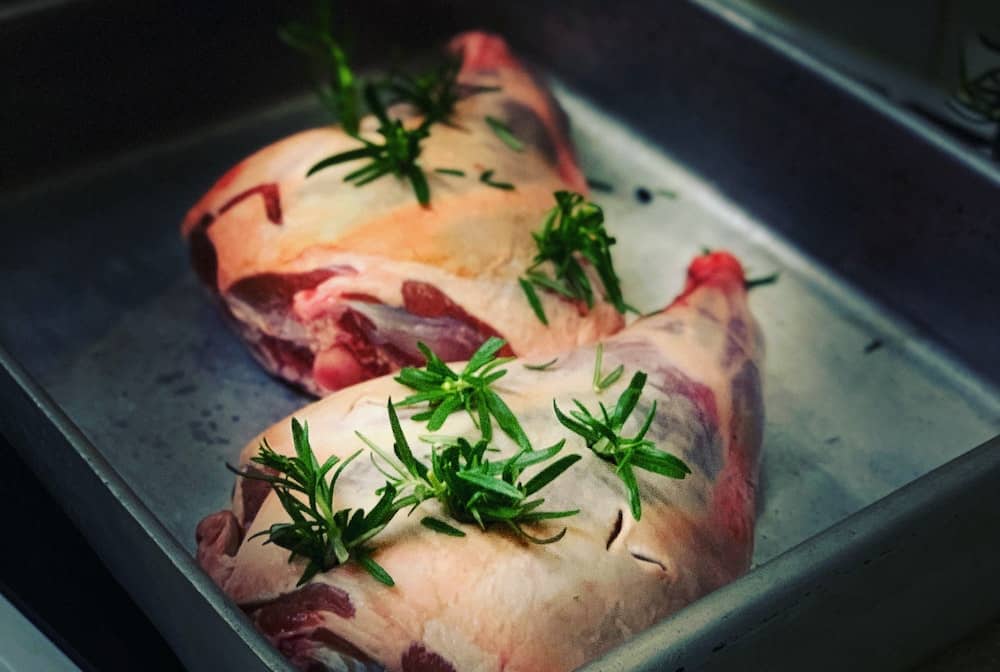If you’ve ever eaten lamb, you may have wondered what type of process it took to get the food onto your plate. Was the lamb you are eating taken care of before it arrived as your next meal?
Eating lamb is cruel because the standard procedures used to slaughter these animals are painful and unethical. In most farms, lambs often endure inhumane living conditions and are killed at six months old. However, it is possible to eat ethically-sourced lamb by buying straight from farmers that you know treat their animals well.
If you’re a meat-eater that isn’t ready to give up lamb – you can read on to find out why eating this meat can be unethical and how to buy it conscientiously. By the end – you will be able to make an informed decision about which part of the meat industry you want to support.
Let’s look a little deeper at the process and how farmers can create a cruelty-free life for these animals.
How the Lambs are Prepared for Slaughter
Lambs are taken away from their mothers at a very young age. A lamb and its mother typically have a strong bond, and the mother can tell when her newborn is no longer around. It is a painful and traumatic process for both mother and baby.
Farmers then wean the lambs off milk early so that they can feed on grass and gain weight faster. It’s a scary thought, but lambs can be slaughtered as early as ten weeks old – and up to 12 months.
Unfortunately, male lambs have it even harder as they are castrated at a young age to improve the quality of their meat. Sometimes the process is done with anesthesia, but not always.
Either way, it can still cause chronic pain after the procedure for the little ones.
Veal is another type of meat that is cruel for similar reasons. Veal comes from baby cows that are slaughtered, sometimes immediately after birth. However, this process is even crueler than lamb, and the reasons will shock you. You can read all about it here: Is Veal Cruel?
What Does the Slaughtering Process Look Like?
Learning about how lambs are slaughtered for their meat is not for the faint-hearted – so buckle up for this next bit.
All animals are slaughtered in different ways, but lambs sent to large abattoirs from commercial farms are usually stunned with an electrical current, and it causes them to lose consciousness right away.
Lambs are Smarter Than you Think
Animals are extremely intelligent, and you can see different qualities shine with each species. Lambs have a great memory and good recognition abilities. Research done proved that lambs could recognize the faces of 50 other sheep and even humans' faces.
When they move in herds, you can keenly see their survival skills in play as they look for a familiar face to sit next to.
Lambs are also capable of building friendships and will express emotion when their friends are taken away. They can be optimistic or pessimistic depending on their environment – just like any human.
Why Do People Eat Lamb?
With all of this considered – people still love to eat lamb, and it is an all-time favorite in many cultures across the world. The roast leg of lamb is considered the national dish of Australia. So from a biological perspective, why do people benefit from eating lamb?
Lamb is a key source of animal-based protein which helps with muscle growth and repair. Additionally, it has essential minerals and vitamins, like B12, iron, and zinc. It’s a high iron source, for example, which is beneficial if you are anemic or are fighting an iron-deficiency.
Unfortunately, eating lamb can have some negative effects too. Some studies show that too much red meat can increase your risk of heart disease or cancer.
Luckily, lamb is not the only source of these essential nutrients – you can find incredible plant-based alternatives that give you all the same benefits of eating lamb without all the negative aspects too.
What Do Animal Rights Organizations Have to Say?
The debate about whether humans should be eating animal meat is certainly not new. Animal rights activists will always show empathy towards the animals that go to slaughter.
PETA is very well known for this, and you can find a lot more about the details of the inhumane transfer of lambs to get prepped for slaughter on their blog.
Some things to consider are that the baby lambs are often chucked into over-crowded trucks and not given food or water when en route to being killed. By the time they get to their destination, they likely are dehydrated and have heat exhaustion.
Thousands of lambs are killed in a single day at a slaughterhouse. Those that don’t make it to the abattoir are likely to die from malnutrition or other health issues.
What is the Farmer’s Take on Eating Lamb?
Farmers believe if the lamb is killed more humanely, the animal will not feel as much pain. If the animal is stunned, they only feel the pain for a brief moment.
Most farmers care for their flock, but they also make their wages by selling the lamb for meat. The best way to do this by providing the highest quality meat to produce a better income for themselves.
What are the Benefits to Tail-Docking?
When a lamb is about a week old, a rubber ring is wrapped around its tail using an elastrator tool. The band prevents blood flow, and the tail will eventually fall off in a week.
While the process is not painless, tail-docking prevents future health issues for the lamb. If a lamb were to keep their long tail, they are more likely to have fecal matter accumulate on their backside.
A lamb’s damp, wet wool is a breeding ground for flies to lay eggs or even bacteria to collect and cause an infection.
Another thing that might look cruel, but is important for lambs and sheep is to shear their wool. Unlike tail-docking, this process is almost entirely painless when it’s done properly. Not to mention that lambs and sheep used for wool are not the same animals used for meat.
So, if you’re worried that wool might be cruel too – we have some good news for you here: Can Wool Be Cruelty-Free?
What Should you Look for When Buying Lamb?
Ideally, you want to be able to look at the packaging of the meat to see if there is any information about where the lamb is from.
The best type of meat will come from organic, grass-fed lamb. You will find your best meat in the summer after the lambs have had time to eat the fresh greens from spring.
You can look for specific labels when buying lamb to ensure you are getting the highest quality meat. These include:
Can You be Cruelty-Free and Still Eat Lamb?
Animal rights activists will tell you there is no cruelty-free way to slaughter an animal. But if you eat meat, the best thing you can do is ensure that it comes from ethical farmers who treat their animals humanely.
If you can, buy straight from your local farmer or butcher instead of buying your lamb from the grocery store. That way, you support your local farmers and can rest assured that these animals had healthy and pain-free lives.
If you are a meat eater and want to get more information around how to ethically source your meat products or what you can do to be a more conscientious shopper, you should definitely read this article: Can you be cruelty free and eat meat?
While there’s no guarantee, supporting local farmers that work hard to ensure ethical treatment of their flock might start can shift the demand from commercially farmed lamb.
Final Thoughts
There is no doubt that lambs can be killed in horrific manners behind closed doors. Doing a little bit of research before you buy lamb at the store can ensure you buy high-quality meat from fairly treated lambs.
There will always be a divide between whether it is acceptable to eat ethically-sourced lamb – but the decision you make is based on your beliefs.
Remember, the farmers that ensure their lambs are treated well and go through a less traumatic process need your support. So, if you want to eat lamb, – make the conscientious decision to buy ethically-sourced meat products.


